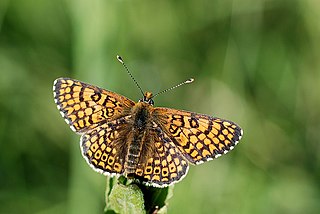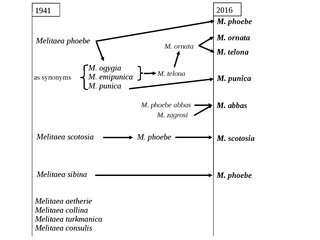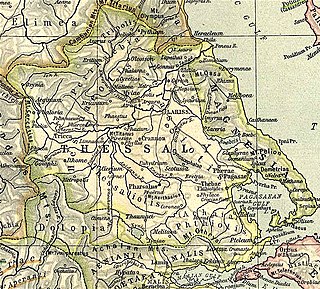
The Glanville Fritillary is a butterfly of the family Nymphalidae. It is named for the naturalist who discovered it and the checkerboard pattern on its wings. These butterflies live in almost all of Europe, especially Finland, and in parts of northwest Africa. They are absent from the far north of Europe and parts of the Iberian Peninsula. To the east they are found across the Palearctic.

Melitaea diamina, the false heath fritillary, is a butterfly of the family Nymphalidae.

Melitaea is a genus of brush-footed butterflies. They are here placed in the tribe Melitaeini of subfamily Nymphalinae; some authors elevate this tribe to subfamily rank.

Melampyrum pratense, the common cow-wheat, is a plant species in the family Orobanchaceae.

Melitaea didyma, the spotted fritillary or red-band fritillary, is a butterfly of the family Nymphalidae.

Melitaea phoebe, the knapweed fritillary, is a butterfly of the family Nymphalidae. It is found in the Palearctic realm, except the northernmost locations. It used to include Melitaea telona, recently revalidated as a distinct cryptic species.

Melitaea trivia, the lesser spotted fritillary, is a butterfly of the family Nymphalidae, part of the sub-family Nymphalinae. It is found in the southern part of the Palearctic realm. In Europe it is sometimes called the desert fritillary, but this name also refers to the North African relative M. deserticola.

Melitaea ornata, the eastern knapweed fritillary, is a butterfly in the family Nymphalidae. The species rank of Melitaea ornata was only very recently recognised by two research groups independently. They realized that there was an unrecognised species in Europe under the name of M. phoebe. The separation of this cryptic species was based on larval morphology from the fourth instar onwards. M. phoebe larvae have a black head capsule while the larvae of this recently recognised Ponto-Mediterranean species have a brick-red head capsule. The separation of the two taxa was also supported by the results of enzyme electrophoresis study. Based on these observations, the name M. telona Fruhstorfer was taken into use for this species. In a recent molecular study, the M. phoebe group forms a monophyletic clade within the subgenus Didymaeformia. Although that study provided important results regarding the systematics of the genus, the members of the phoebe species group were poorly represented, and the need for a detailed examination of this group remained. One of the important results was the corroboration of the species rank of M. telona and the suggestion that the taxon punica may represent a separate species from both M. telona and M. phoebe. Another recent study on the morphometry of genitalia in males and females of the phoebe species group provided additional information. An analysis of a large number of specimens from the Palaearctic showed that Melitaea telona is not restricted to the Ponto-Mediterranean region since several new localities were found, including the Orenburg region (Russia), northern Iran and the easternmost border of Kazakhstan. Since the name ornata described by Hugo Theodor Christoph in 1893 is older than the name telona, the authors began to use M. ornata as the valid name for this species following the rule of priority. Recently, it has also been indicated that M. telonasensu stricto from Israel and M. ornata are different taxa. Previous morphometrical studies have already revealed small differences in the genital structures of the males but the authors interpreted the difference as a well-pronounced intra-specific difference. In contrast, molecular data clearly showed that the two taxa are genetically distinct from each other. Based on the results of the analysis of seven genes, Tóth et al. (2014) concluded that M. telona is not a subspecies of M. ornata but a species in its own right.

Melitaea arduinna, or Freyer's fritillary, is a butterfly of the family Nymphalidae. It is found from south-eastern Europe across Asia Minor to central Asia and the Altai. The habitat consists of steppe-clad slopes.

Melitaea persea is a butterfly of the family Nymphalidae. It is found from Iran and Asia Minor to Afghanistan and the western parts of the Tian Shan mountains.

Melitaea nevadensis is a species of butterfly of the family Nymphalidae.

Melitaea or Meliteia was a town and polis (city-state) of Phthiotis in ancient Thessaly, situated near the river Enipeus, at the distance of 10 stadia from the town of Hellas, whence the residents of Melitaea had come. The inhabitants of Melitaea affirmed that their town was anciently called Pyrrha, and they showed in the agora the tomb of Hellen, the son of Deucalion and Pyrrha. According to Greek mythology its eponymous founder had been Melitaea and there was a legend according to which Aspalis, a beautiful maiden of the place, had been hanged to avoid being possessed by a tyrant of the city which they called Tartarus. Astygites, the brother of Aspalis, killed the tyrant after disguising himself as his sister. It was believed that the body of Aspalis was not found because it was taken by the gods and in its place a statue appeared next to another statue of Artemis that was already in the city. In this new statue, called Aspalis Amilete Hekaërge, the maidens of the city hung a virgin goat every year, just as Aspalis had been hanged as a virgin.












